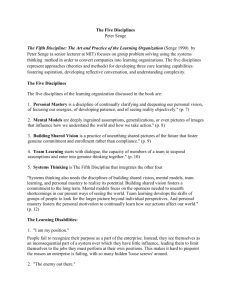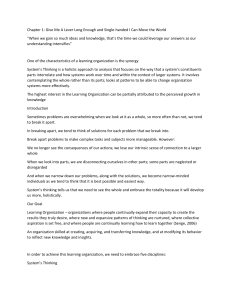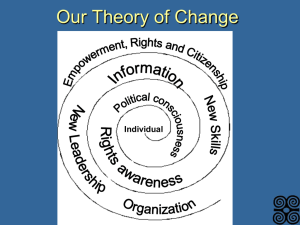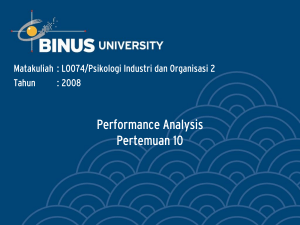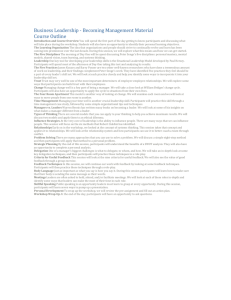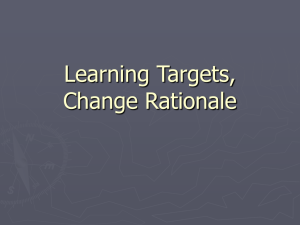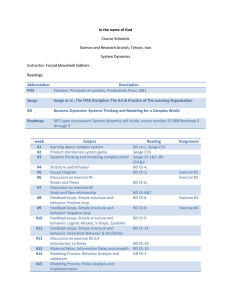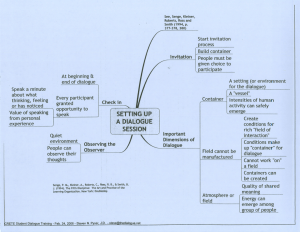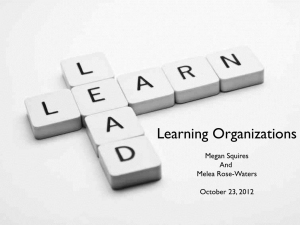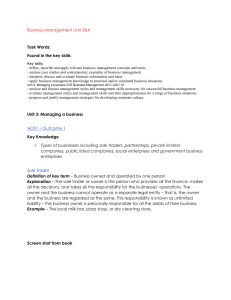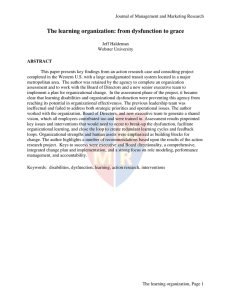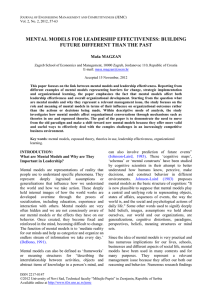Make Learning Matter: Become a Learning Organization What's a Learning Organization?
advertisement
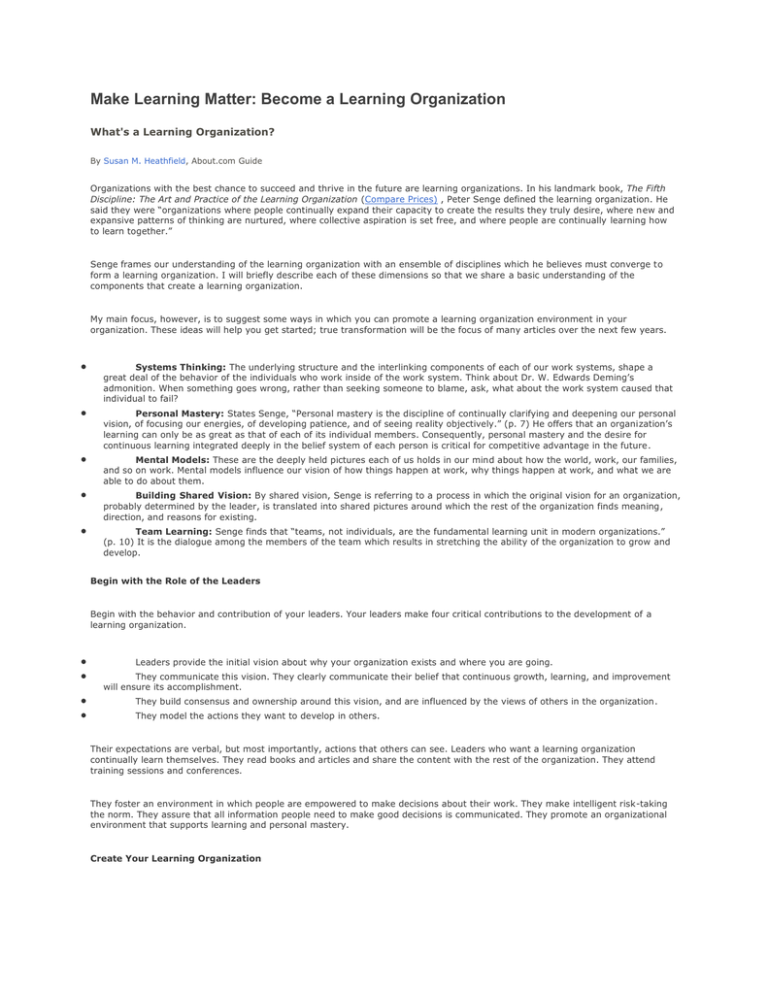
Make Learning Matter: Become a Learning Organization What's a Learning Organization? By Susan M. Heathfield, About.com Guide Organizations with the best chance to succeed and thrive in the future are learning organizations. In his landmark book, The Fifth Discipline: The Art and Practice of the Learning Organization (Compare Prices) , Peter Senge defined the learning organization. He said they were “organizations where people continually expand their capacity to create the results they truly desire, where new and expansive patterns of thinking are nurtured, where collective aspiration is set free, and where people are continually learning how to learn together.” Senge frames our understanding of the learning organization with an ensemble of disciplines which he believes must converge to form a learning organization. I will briefly describe each of these dimensions so that we share a basic understanding of the components that create a learning organization. My main focus, however, is to suggest some ways in which you can promote a learning organization environment in your organization. These ideas will help you get started; true transformation will be the focus of many articles over the next few years. Systems Thinking: The underlying structure and the interlinking components of each of our work systems, shape a great deal of the behavior of the individuals who work inside of the work system. Think about Dr. W. Edwards Deming’s admonition. When something goes wrong, rather than seeking someone to blame, ask, what about the work system caused that individual to fail? Personal Mastery: States Senge, “Personal mastery is the discipline of continually clarifying and deepening our personal vision, of focusing our energies, of developing patience, and of seeing reality objectively.” (p. 7) He offers that an organization’s learning can only be as great as that of each of its individual members. Consequently, personal mastery and the desire for continuous learning integrated deeply in the belief system of each person is critical for competitive advantage in the future. Mental Models: These are the deeply held pictures each of us holds in our mind about how the world, work, our families, and so on work. Mental models influence our vision of how things happen at work, why things happen at work, and what we are able to do about them. Building Shared Vision: By shared vision, Senge is referring to a process in which the original vision for an organization, probably determined by the leader, is translated into shared pictures around which the rest of the organization finds meaning, direction, and reasons for existing. Team Learning: Senge finds that “teams, not individuals, are the fundamental learning unit in modern organizations.” (p. 10) It is the dialogue among the members of the team which results in stretching the ability of the organization to grow and develop. Begin with the Role of the Leaders Begin with the behavior and contribution of your leaders. Your leaders make four critical contributions to the development of a learning organization. Leaders provide the initial vision about why your organization exists and where you are going. They communicate this vision. They clearly communicate their belief that continuous growth, learning, and improvement will ensure its accomplishment. They build consensus and ownership around this vision, and are influenced by the views of others in the organization. They model the actions they want to develop in others. Their expectations are verbal, but most importantly, actions that others can see. Leaders who want a learning organization continually learn themselves. They read books and articles and share the content with the rest of the organization. They attend training sessions and conferences. They foster an environment in which people are empowered to make decisions about their work. They make intelligent risk-taking the norm. They assure that all information people need to make good decisions is communicated. They promote an organizational environment that supports learning and personal mastery. Create Your Learning Organization To become a learning organization, everyone must contribute. Following are my ideas about how you can ensure the development of this environment at work. (They are in no particular order; the more you do, the better your results.) Read together. One printing shop, with thirty employees, set aside two lunch hours per week to read and discuss the book, The Goal, as a group.The marketing staff of a software development company voted on a book to read. The department members took turns leading the discussion of various chapters at staff meetings. The leadership team in a student health center read, Leading Change, together. The group discussed concepts and chapters at their weekly leadership team meeting. Attend training and conferences. A recent study by the American Society for Training and Development suggests that there is a direct “causative relationship between training and performance but doesn’t prove it.” (The ASTD Benchmarking service continues to gather data each year which may prove the relationship over time.) Create the expectation that anyone who attends training or a conference will make presentations to other staff about the most important learning they took away from the event. Provide alternative sources for learning such as CDs and online learning. Debrief every project and initiative. If you have developed a new product, designed an ad campaign, or purchased new equipment, to cite a few examples, don’t just move on to the next activity. Bring together everyone in the organization who contributed to the success or failure of the initiative. Debrief what went right, what went wrong, and what you will do differently in the future. Learn from each project, initiative, and activity. In the debriefing process, seek not to place blame; aim for shared understanding. In the process, create an environment in which people feel safe to share the truth about what really happened Here are twelve more tips about how to become a learning organization. Build individual development plans quarterly. These should list negotiated expectations for growth and learning over the quarter. These plans may include cross-training, skill stretching assignments, and representing the department at organization-wide meetings, as well as education. Put each person directly into contact with customers. When each individual personally knows customer needs, she is enabled to make better decisions to satisfy the customer. Remember also, the internal customers. Anyone to whom you provide a product or a service is a customer. Promote field trips to other organizations. Even organizations in different industries can provide opportunities for learning. See and learn what others are doing about the challenges you experience in your organization. I have found noncompeting companies surprisingly gracious about sharing information. Meet regularly across departments, or in a smaller organization, as a whole company. Even in a larger organization, bring the whole company together, at least quarterly. People have to understand the whole work system; otherwise they improve just their small part of the system. While these small improvements are important, they do not necessarily optimize the success of the entire system. This is an area in which every technological advancement makes meeting easier. Use cross-functional teams to solve problems, scout for new opportunities, and cross-fertilize units with new ideas. Pay for education for all employees. In fact, some forward thinking organizations have determined learning is so important, that they pay for any educational pursuit, not just those related exclusively to the individual’s current job. The goal is to foster learning and they presume that any investments in learning translate into more effective work performance over time. Coach improved performance from all members of the organization. Work constantly to enable people to set and achieve their next goals. Spend time with people thinking about and planning their next objective. Form study groups. Internally, and even externally, these groups can focus on creating a learning organization or any other topic that interests you. Check Peter Senge's Fieldbook.com Web site for more information about organizing these groups. There may be people, who are close to you geographically, seeking members or holding group meetings. Take time to read, to think, to talk about new ideas and work. Create discussion areas, conference rooms, and break areas that foster people communicating. Hold brainstorming (idea generation) sessions on specific topics. Bring "experts" in to help you. As an example, a technical writer can add value to a discussion about print presentation. Foster an environment of collegiality. Recently, I attended a meeting led by a young manager. I watched the interaction for a few minutes as she provided direction and led a discussion. The most striking feature of the interaction was that she talked to the group as if they were all colleagues working on the same goal. She demonstrated no need to be more important than any member of the group. Use your performance management system effectively. In addition to the development plan, mentioned above, provide 360 degree feedback from peers, reporting staff members, and the boss.
